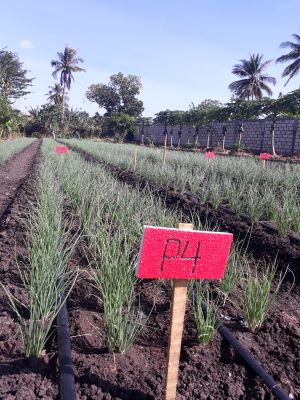
Effects of water hyacinth compost and biological agents (Trichoderma sp) on the growth and yield of shallots (Allium ascalonicum L.) in dry land
Laurensius Lehar(1*), Tri Luchi Proklamita(2), Zainal Arifin(3)
(1) State Agricultural Polytechnic of Kupang- Indonesia
(2) State Agricultural Polytechnic of Kupang- Indonesia
(3) State Agricultural Polytechnic of Kupang- Indonesia
(*) Corresponding Author
Abstract
Shallot (Allium ascalonicum L.) is one of leading vegetable commodities intensively cultivated by farmers for a long time, including farmers in East Nusa Tenggara (ENT). The purpose of this study was to produce water hyacinth compost with ability to interact with Trichoderma sp. in order to improve the shallot bulb quality cultivated in dry land. This factorial experimental research was arranged in a Split Plot Design with 10 treatments and 3 replications. There were 10 treatment combinations with 30 experimental plots. Two factors were tested in this research. The first factor was the water hyacinth compost as the main plot, namely: 15 ton ha⁻¹ water hyacinth compost (K1) and without water hyacinth compost (K2), while the second factor as a sub-plot was the concentration of Trichoderma sp., consisting of watering with plain water (as control) of 100 mL(P0), watering with a concentration of Trichoderma sp. 5 mL.L⁻¹ (P1), watering with a concentration of Trichoderma sp. 10 mL.L⁻¹ (P2), watering with Trichoderma sp. concentration 15 mL.L⁻¹ (P3) and watering with Trichoderma sp. 20 mL.L⁻¹ (P4). The treatment of water hyacinth compost fertilizer at 15 tons ha⁻¹ with a concentration of Trichoderma sp 20 mL.L⁻¹ resulted in the highest number of shallot leaves (84.27 strands) and tillers (10.82). The shallot bulb weight per plot was 2455.33 g, and the number of bulbs per plot was 350.40 bulbs.
Keywords
Full Text:
PDFReferences
Agustini, Y., Purwatiningsih, and Sulistyanto, D. (2017). Kombinasi Pupuk Organik dan Agen Hayati Untuk Mengendalikan Hama Spodoptera exigua pada Tanaman Bawang Merah di Kecamatan Gending, Kabupaten Probolinggo. Jurnal Ilmu Dasar, 18(2), pp. 99–108.
Badan Pusat Statistik Jawa Tengah. (2020). Dinas Pertanian dan Perkebunan Provinsi Jawa Tengah. [online] Available at : https://jateng.bps.go.id/indicator/55/727/1/luas-panen-dan-produksi-bawang-merah.html [Accessed 5 Januari 2024].
Badan Pusat Statistik Nusa Tenggara Timur. (2020). Vegetables Production (Quintal). [online] Available at: https://ntt.bps.go.id/indicator/55/595/1/produksi-tanaman-sayuran-menurut-kabupaten-kota.html [Accessed 5 Januari 2024].
Baihaqi, A., Nawawi M., and Abadi A.L. (2013). Teknik Aplikasi Trichoderma sp. Terhadap Pertumbuhan dan Hasil Tanaman Kentang (Solanum tuberosum L.). J. Produksi Tanaman, 1(3), pp. 30–39.
Dewi, M.K., and Sutrisna, I.K. (2016). Pengaruh Tingkat Produksi, Harga, dan Konsumsi Terhadap Impor Bawang Merah di Indonesia. J Ekonomi Pembangunan Unud, 5(1), pp 117–137.
Kusrinah, N., Alwiyah., Nur H. (2016). Pelatihan dan Pendampingan Pemanfaatan Eceng Gondok (Eichornia crasspes L.) Menjadi Pupuk Kompos Cair Untuk Mengurangi Pencemaran Air dan Peningkatkan Ekonomi Mayarakat Desa Karangkimpul Kelurahan Klaigawe Kecamatan Gayamsari Kotamadya Semarang. Jurnal UIN, 16 (1), pp. 27–48.
Komara, W. (2016). Pengaruh Pemberian Kompos Eceng Gondok (Eichornia crassipes) Terhadap Pertumbuhan Dan Hasil Bawang Merah (Allium ascalonicum L.) B.A. Universitas Andalas.
Lehar, L., Arifin, Z., Heny, M.C.S. (2021). Pengujian Pupuk Kompos Eceng Gondok Dan Agen Hayati (Trichoderma sp) Terhadap Pertumbuhan Dan Penyakit Layu Fusarium Pada Budidaya Bawang Merah (Allium ascalonicum L.) Di Lahan Kering. Jurnal Ilmiah Hijau Cendekia, 6(2), pp. 86–92.
Lehar, L., Wardiyati, T., Maghfoer, M.D., and Suryanto, A. (2017). Influence of mulch and plant spacing on yield of Solanum tuberosum L .cv. Nadiya at medium altitude. International Food Research Journal, 24(3), pp. 1338–1344.
Lehar, L., Wardiyati, T., Maghfoer, M.D., Suryanto, A. (2016). Selection of potato varieties (Solanum tuberosum L.) in midlands and the effect of using biological agents. Int. J. of Biosci, 9(3), pp. 129–138.
Lehar L. 2012. Pengujian pupuk organik agen hayati (Trichoderma sp) terhadap pertumbuhan kentang (Solanum tuberosum L.). J. Penelitian Pertanian Terapan, 12(2), pp. 115–124.
Lende, A.N., Laurensius, L., and Heny, M.C.S. (2020). Application of organic fertilizer and Pseudomonas fluorescens on the growth and yield of shallot cultivar Sabu Raijua (Allium ascalonicum L.) in dry land. GSC Advanced Research and Reviews, 05(02), pp. 123–130.
Nurman, N., Elsa, Z., Isna, R.D. (2017). Pemanfaatan Zpt Air Kelapa Dan Poc Limbah Cair Tahu Untuk Pertumbuhan Dan Produksi Bawang Merah (Allium ascalonicum L.). JOM Faperta UR, 14(2), pp. 1–15.
Prasetyo A dan Ernita. (2022). Respon Pertumbuhan serta Produksi Tanaman Bawang Merah (Allium ascalonicum L.) terhadap Pupuk NPK Organik dan POC Urin Sapi. Jurnal Agroteknologi Agribisnis dan Akuakultur, 2(2), pp. 1–13.
Septania, V.P., Saidah, and Basri, Z. (2022). Pertumbuhan Dan Hasil Bawang merah (Allium ascalonicum L.) Pada Kombinasi Trichoderma assparellum Dan Pupuk Kandang. Jurnal Agrotech, 12(1), pp. 1–9.
Sianturi, R.I.E.S., Mukarlina, M., Zakiah, Z. (2021). Pertumbuhan Bawang Merah (Allium ascalonicum L. var. bauji) Dengan Pemberian Pupuk Organik Cair Campuran Limbah Kulit Nanas (Ananas comosus L.) Dan Eceng Gondok (Eichornia crassipes L.). Jurnal Protobiont, 10(3), pp. 60–64.
Sittadewi E.H. (2007). Pengolahan Bahan Organik Eceng Gondok Menjadi Media Tumbuh Untuk Mendukung Pertanian Organik. Jurnal Teknik Lingkungan, 8(3), pp. 229–234.
Sukmasari, M.D., Ita, Y., Adi, O.R.H. (2023). Pengaruh jarak tanam dan penggunaan pupuk hayati terhadap pertumbuhan dan hasil tanaman bawang merah (Allium ascalonicum L.) Varietas Bali Karet. Agrivet: Jurnal Ilmu-Ilmu Pertanian Dan Peternakan, 11(1), pp. 29–36.
Suprapta, D.N. (2012). Potential of microbial antagonists as biocontrol agents against plant fungal pathogens. International Society for Southeast Asian Agricultural Sciences J, 18(2), pp. 1–8.
Yustiningsih, M. (2019). Intensitas Cahaya dan Efisiensi Fotosintesis pada Tanaman Naungan dan Tanaman Terpapar Cahaya Langsung. Bio-Edu Jurnal Pendidikan Biologi, 4(2), pp. 43–48.
Article Metrics
Refbacks
- There are currently no refbacks.
Ilmu Pertanian (Agricultural Science) ISSN 0126-4214 (print), ISSN 2527-7162 (online) is published by Faculty of Agriculture Universitas Gadjah Mada collaboration with Perhimpunan Sarjana Pertanian Indonesia (PISPI) and licensed under a Creative Commons Attribution-ShareAlike 4.0 International License.











_2025_-_kecil_.png)
_2024_kecil_2.png)
